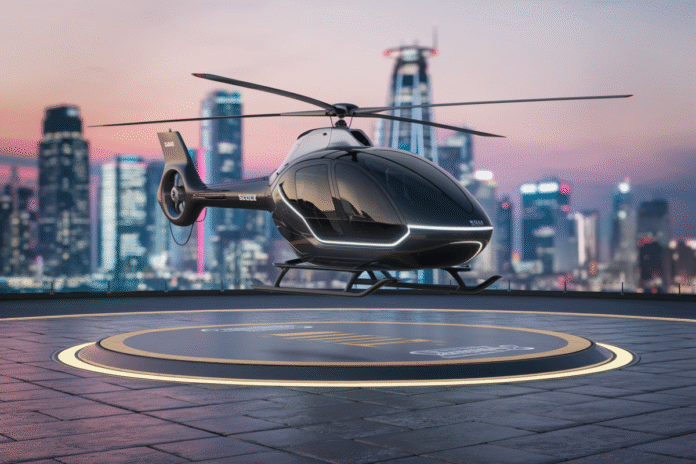“The sky is no longer the limit.” As urban congestion reaches critical levels, innovative solutions are emerging to redefine transportation. The partnership between a renowned motorcycle manufacturer and a pioneering eVTOL taxi startup signals a transformative shift in urban mobility. With the advent of all-electric taxi helicopters, the dream of aerial commuting is inching closer to reality. How will this collaboration reshape the future of transportation and urban landscapes?
The stakes are high as cities grapple with traffic congestion and environmental concerns. The introduction of electric vertical takeoff and landing (eVTOL) vehicles promises not only to alleviate ground traffic but also to reduce carbon emissions significantly. This collaboration aims to harness cutting-edge technology to create a fleet of aerial taxis that can operate efficiently within urban environments. What implications will this have for traditional transportation methods, and how will it affect commuters in major metropolitan areas?
Revolutionizing Urban Mobility
The partnership between Suzuki and SkyDrive marks a pivotal moment in the evolution of urban transportation. By combining Suzuki’s expertise in manufacturing and engineering with SkyDrive’s innovative approach to aerial mobility, the duo aims to create a new mode of transport that can seamlessly integrate into existing urban infrastructure. This collaboration is not just about flying cars; it represents a comprehensive strategy to redefine how people navigate cities.
SkyDrive’s vision for eVTOL technology includes a focus on safety, efficiency, and sustainability. The all-electric helicopters are designed to operate quietly and with minimal environmental impact, making them ideal for urban settings. By utilizing advanced battery technology and aerodynamics, these vehicles can offer a range of services, from passenger transport to emergency medical services. The potential market for such innovations is vast, with estimates suggesting that the eVTOL market could reach billions of dollars in the coming years.
As urban populations continue to swell, the demand for efficient transportation solutions grows. The integration of eVTOLs into public and private transportation networks could drastically reduce travel times, offering a viable alternative to traditional taxis and ride-sharing services. However, the success of this venture will depend on regulatory frameworks and public acceptance. How will cities adapt to accommodate these flying taxis, and what regulations will ensure their safe operation?
Technological Innovations Driving Evtol Development
At the core of this partnership lies a commitment to harnessing cutting-edge technology. The development of eVTOL vehicles involves significant advancements in battery efficiency, materials science, and autonomous flight systems. These innovations are crucial for creating aircraft that are not only safe and reliable but also capable of operating in densely populated areas.
Battery technology has seen remarkable progress in recent years, with companies developing lighter, more efficient power sources. This is essential for eVTOLs, which require significant energy to achieve vertical takeoff and maintain flight. Furthermore, advancements in artificial intelligence and machine learning are paving the way for autonomous flight systems that can navigate complex urban environments safely. The combination of these technologies positions Suzuki and SkyDrive at the forefront of the eVTOL revolution.
However, the road to widespread adoption is fraught with challenges. Regulatory bodies must establish comprehensive guidelines to ensure airspace safety and manage the integration of eVTOLs into existing air traffic systems. Additionally, public perception plays a crucial role; educating potential users about the benefits and safety of aerial taxis will be vital for their acceptance. Will the public embrace this new mode of transportation, or will skepticism hinder its growth?
Environmental Impact and Sustainability Goals
As the world grapples with climate change, the push for sustainable transportation solutions has never been more urgent. The partnership between Suzuki and SkyDrive aligns with global sustainability goals by introducing all-electric vehicles that produce zero emissions during operation. This initiative not only addresses urban air quality concerns but also contributes to broader efforts to combat climate change.
Electric vehicles, including eVTOLs, have the potential to significantly reduce greenhouse gas emissions compared to traditional fossil fuel-powered transportation. By transitioning to electric aerial taxis, cities can take a substantial step towards achieving their sustainability targets. Moreover, the use of renewable energy sources to charge these vehicles further enhances their environmental benefits. The implications for urban planning and development are profound, as cities may need to rethink infrastructure to support this new mode of transport.
However, the environmental impact extends beyond emissions. The production and disposal of batteries pose additional challenges that must be addressed to ensure that the entire lifecycle of eVTOLs is sustainable. As the industry evolves, it will be essential to implement recycling programs and invest in sustainable materials to minimize the ecological footprint of these innovative vehicles. How can the industry balance technological advancement with environmental responsibility?
The Future of Aerial Transportation
The collaboration between Suzuki and SkyDrive represents a bold step into the future of transportation. As urban centers continue to grow, the need for innovative solutions that prioritize efficiency, safety, and sustainability becomes increasingly critical. The integration of eVTOLs into everyday life could fundamentally change how people commute, travel for business, and access essential services.
Looking ahead, the success of this partnership will hinge on several factors, including technological advancements, regulatory frameworks, and public acceptance. As cities begin to explore the possibilities of aerial taxis, the potential for economic growth and job creation in the aviation sector is significant. Furthermore, the introduction of eVTOLs could stimulate investments in infrastructure and technology, fostering innovation across various industries.
The journey to realizing the vision of all-electric taxi helicopters will undoubtedly be complex, but the potential rewards are immense. As Suzuki and SkyDrive forge ahead, their partnership may well serve as a blueprint for future collaborations in the quest for sustainable urban mobility. Will aerial taxis become a common sight in our skies, reshaping the way we think about transportation? Only time will tell.


